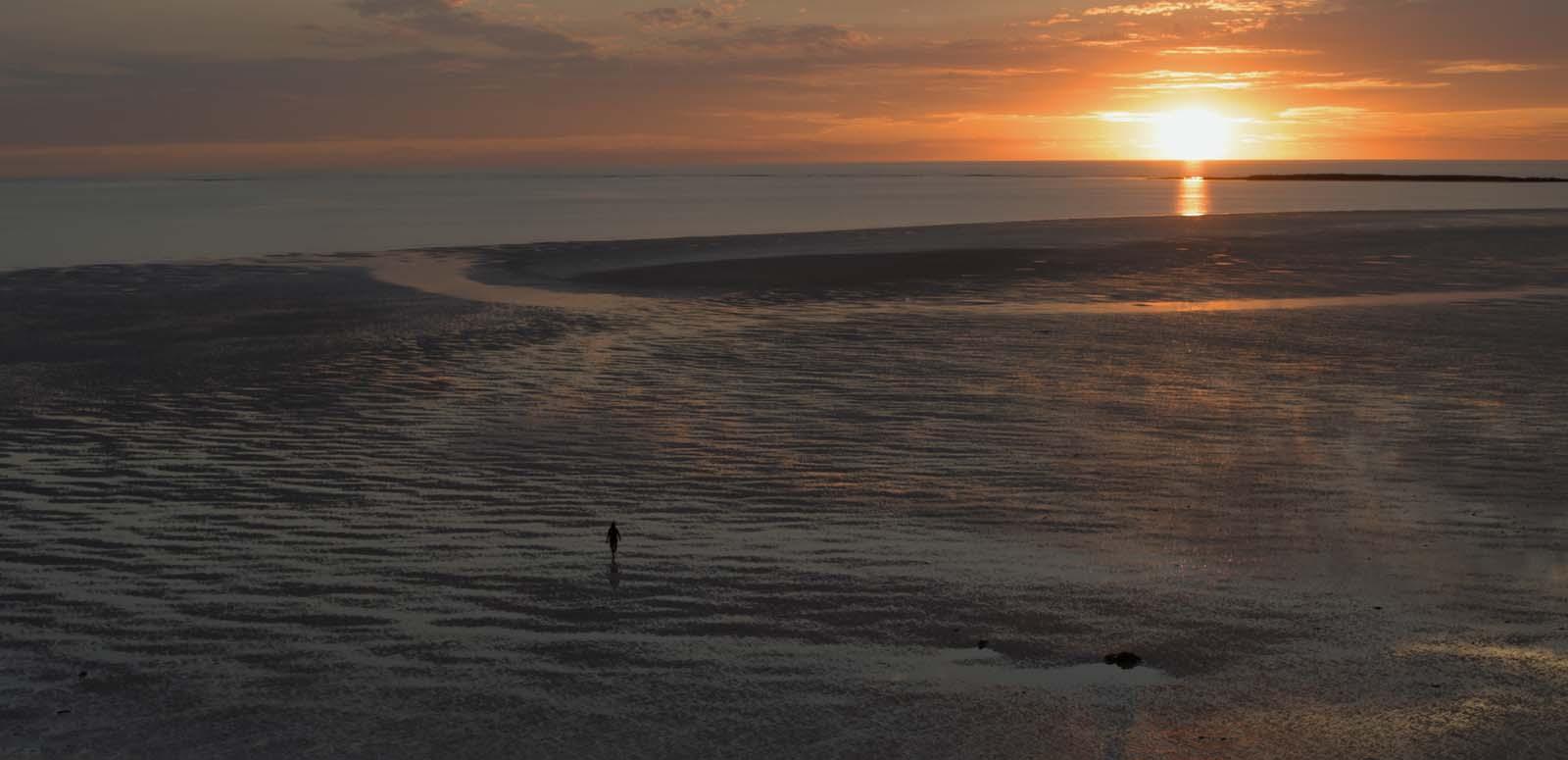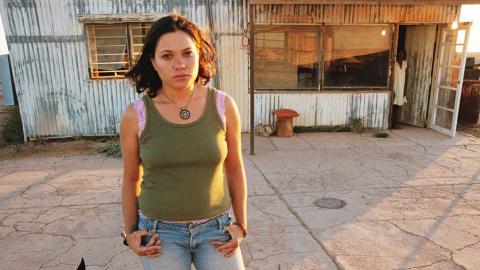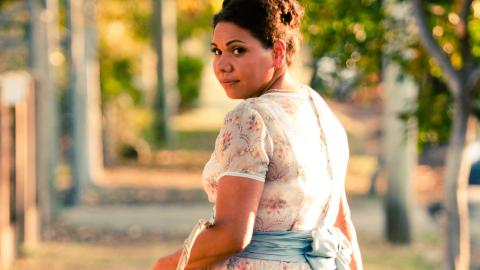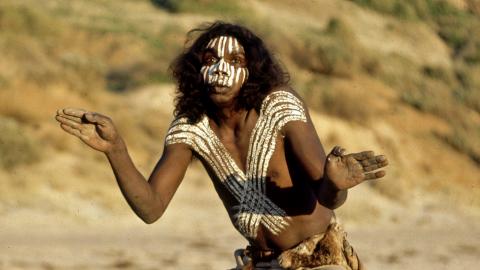

Indigenous Filmmaking: A Short History
A Short History of First Nations Filmmaking in Australia
WARNING: this article may contain names, images or voices of deceased Aboriginal and Torres Strait Islander people.
After almost a century of silence as a creative voice in screen culture, First Nations filmmakers, within a generation, became a vibrant presence in the centre of filmmaking in Australia. Liz McNiven explores the short but significant move from being in front of to behind the camera.

In a relatively short space of time, Australian films have jumped from depicting Aboriginal and Torres Strait Islander peoples through racist clichés to First Nations creatives using film and television to document their cultures, promote social change and to entertain, thus entering the mainstream. This is highlighted by critical and box-office hits from directors like Rachel Perkins, Warwick Thornton and Wayne Blair, which deal with complex Indigenous issues and feature Aboriginal actors and characters.
This reshaping of a cultural landscape and determined shift for Australian cinema’s national identity came about through a gradual reframing of First Nations rights within the Australian legal system, combined with government support for the development of Aboriginal and Torres Strait Islander filmmakers.
Blackface and disadvantage
Early representations of Aboriginal Australians on film were often played by non-Indigenous people in blackface and lacked any resemblance to the actual peoples or their customs and traditions. Unfortunately, this misinterpretation of First Nations peoples and their cultures in turn influenced and perpetuated the broader population’s perceptions. When First Nations people did get to play a major role in feature films, it was as the subordinate sidekick or a primitive savage. In either case, they were cast as racially inferior to the white characters. Leading film archivist Michael Leigh concluded in his essay ‘Curiouser and Curiouser’ in Back of Beyond, Discovering Australian Film and Television (1988):
'These films, which today resemble Tropicana surrealism more than any possible reality, presented their ‘natives’ as the less-than-Noble Savage, cast generally as lazy, shiftless, crafty and filled with either lust or vague mystical foreboding … The Aboriginal [character] became a stock symbol for the hostility Europeans so wrongly perceived in a landscape so different from that on which their own cultures were based. Being strangers in an even stranger land, these nomadic invaders used imagery as a sleight-of-hand to transfer their displacement and alienness to [Aboriginal peoples].'
Australian government legislation played its part by severely limiting the capacity of First Nations peoples to participate in society. In the 1960s, however, things began to change. The United Nations challenged all countries to recognise the human rights of their citizens. With mounting domestic pressure to divert international exposure, the Australian Government removed numerous discriminatory references from its laws and, through a referendum, from the Australian constitution. These changes alone failed to lessen the socio-economic disadvantage suffered by the majority of Aboriginal and Torres Strait Islander peoples or alter the broader population’s prejudice.
1970s activism
In the 1970s, a young and fiery generation of Aboriginal activists renewed the protest for Aboriginal land rights in Australia; they conveyed their political message through direct action and by utilising film and television. In 1972, Aboriginal people took their struggle to the lawns of Parliament House in Canberra and, via television and radio coverage, to the world. This media exposure rallied activists from the anti-war, civil rights and feminist movements, and enlisted new supporters from more conservative quarters. They joined Aboriginal activists in calling on the federal government to legislate Aboriginal land rights. The documentary Ningla A-Na (1972), produced and directed by Alessandro Cavadini, documents this historic event. The film contains the news footage of police overpowering and brutalising the protestors. Seen worldwide, the film highlighted to an international audience the Aboriginal struggle for land rights.
Aboriginal activists then spearheaded a new movement and initiated a revolution in Indigenous policy in Australia. The newly elected Whitlam Government dumped the assimilation policy, opting instead for Aboriginal self-determination. Most importantly the Whitlam Government domestically implemented human rights legislation in the form of the Racial Discrimination Act 1975. These legislative and policy changes created new opportunities for Aboriginal and Torres Strait Islander peoples.
Bruce McGuiness made two films during this period – Blackfire (1972) and A Time to Dream (1974) – and was a forerunner in First Nations filmmaking and self-representation and self-empowerment in the arts. He was long assumed to be Australia's first Aboriginal filmmaker but the documentary Ablaze (Tiriki Onus and Alec Morgan, 2021) uncovered a late 1940s film made by Bill Onus, a Yorta Yorta and Wiradjuri man from Victoria. Onus grew up on the Cummeragunga mission and learned about movie-making while working as an assistant on Charles Chauvel’s Uncivilised (1936) and later as a cultural advisor to Harry Watt on The Overlanders (1945).
In the mid-1970s a small group of Aboriginal people attended a workshop at the Black Theatre in Redfern, to gain access to training in the arts. Ande Reese documented this six-week workshop in her film Tjintu Pakani: Sunrise Awakening (1976). The students featured in Tjintu Pakani went on to influence, teach and mentor other First Nations people, sharing their knowledge, skills and expertise across Australia and beyond. They became legendary trailblazers in the Indigenous arts world.
As Aboriginal and Torres Strait Islander activists advocated for self-representation in film, some non-Indigenous filmmakers responded by facilitating the process. The most outstanding of these early collaborations include Martha Ansara and Essie Coffey with My Survival as an Aboriginal (1978), and Alec Morgan and Gerry Bostock with Lousy Little Sixpence (1983, excerpt below). These films provide an alternate perspective on First Nations cultures, stories and histories:
Excerpt from Lousy Little Sixpence, 1983. NFSA title: 9408
Telling their own stories
In the early 1980s, the Film Unit of the Australian Institute of Aboriginal Studies (AIAS, now the Australian Institute of Aboriginal and Torres Strait Islander Studies – AIATSIS) employed a number of trainees including Wayne Barker and Coral Edwards. Coral Edwards directed It’s a Long Road Back (1981) and, in collaboration with AIAS ethnographic filmmaker David MacDougall, Link-up Diary (1987). Wayne Barker worked on several AIAS films and directed a film about his grandfather, Cass: No Saucepan Diver (1983). After leaving AIAS, Barker wrote and directed another 10 films. His documentaries Milli Milli (1994) and Spirit of Anchor (2002) received a number of international awards.
With a background in commercial television, Ralph Rigby, AIAS Video Fellow in the 1980s, facilitated rural and remote Aboriginal community access to video technology. In doing so, he enabled First Nations peoples to tell their stories in their own way. His video clip for Bobby McLeod’s song 'Wayward Dreams’ (1988) blended historical footage and contemporary images to highlight the connection between Aboriginal peoples of the past and present. Rigby, a student at the Black Theatre in Redfern and in Ande Reese’s film Tjintu Pakani: Sunrise Awakening (1976), later worked with the Townsville Aboriginal and Islander Media Association (TAIMA) where he managed the Video Unit and taught video production to Aboriginal and Torres Strait Islander trainees. In 1988, Rigby and the TAIMA Video Unit trainees worked on three productions covering the 5th Festival of Pacific Arts in Townsville.
Madeline McGrady directed a number of politically motivated films throughout the 1980s including We Fight (1982), Welcome to Wee Waa (1983), Stand Up For Your Rights (1987) and Always Was, Always Will Be (1987). In making these films McGrady claimed space for First Nations activism within the film industry. Lorraine Mafi-Williams produced Eelemarni, The Story of Leo and Leva (1988), a short video of a Bundjalung story told in both Bundjalung language and in English. Around the same time, Tracey Moffatt directed a series of short films including Nice Coloured Girls (1987), Night Cries: A Rural Tragedy (1989) and the feature film BeDevil (1993, excerpt below). McGrady, Mafi-Williams and Moffatt paved the way for Aboriginal women in the film industry.
Excerpt from BeDevil, 1993. Courtesy: Tracey Moffatt and Roslyn Oxley Gallery. NFSA title: 239068
Indigenous television
The mid-1980s brought the establishment of the Central Australian Aboriginal Media Association (CAAMA) in Alice Springs. CAAMA aimed to utilise audiovisual technology for cultural maintenance, self-expression and empowerment. Soon after, CAAMA moved into television broadcasting with Imparja Television. As a result CAAMA became the first First Nations organisation in the world to own a television station. In 1987, Aboriginal people in remote areas of central Australia voiced their concerns about the influence of mass media on their cultures. The Australian satellite Aussat was being launched and Aboriginal people requested resources to enable them to broadcast local material in their own languages. They also sought to control the content broadcast within their communities. In response, the federal government introduced the Broadcasting for Remote Aboriginal Communities Scheme to deliver radio and television to rural and remote Aboriginal and Torres Strait Islander communities.
Excerpt from Satellite Dreaming (Ivo Burum), 1991. Courtesy CAAMA Productions
The Royal Commission into Aboriginal Deaths in Custody outlined in its final report (1991) a number of recommendations with direct reference to public and commercial media organisations and their treatment of Aboriginal and Torres Strait Islander peoples. The commission recommended that media bodies develop codes and policies for the presentation of Indigenous issues and establish training for First Nations peoples. These recommendations marked a turning point in the television industry. They supported First Nations peoples having influence over their own representation and increased their access to employment within the film and television industry.
In a landmark decision in 1992, the High Court of Australia recognised that Aboriginal and Torres Strait Islander property rights extended beyond British settlement until extinguishment – in some cases into the present. The same year the Australian Film Commission (AFC) commissioned a report by Shirley McPherson and Michael Pope, Promoting Aboriginal and Torres Strait Islander Involvement in the Film and Television Industry (1992). On its recommendation, the AFC established the Indigenous Branch in 1993. After decades on the fringes of the film and television industry, Aboriginal and Torres Strait Islander people were finally gaining access to the technology, training and resources necessary to write, direct and produce film. The branch’s first drama initiative saw six short films released in 1996 under the title From Sand to Celluloid.
As manager of the branch, Walter Saunders also produced the subsequent series Shifting Sands (1998) and Crossing Tracks (1999). These groundbreaking and award-winning short films established a First Nations niche in the industry and forged a pathway for the development of First Nations filmmakers and film administrators. With the release of Terri Janke’s Pathways and Protocols: A Filmmaker's Guide to Working with Indigenous People, Culture and Concepts (2009), the AFC (now part of Screen Australia) continued to guide the industry on culturally appropriate practice and to develop a critical mass of Aboriginal and Torres Strait Islander filmmakers.
These filmmakers offer Australians an alternative way of seeing and understanding First Nations peoples and their cultural landscapes. Celebrated Aboriginal and Torres Strait Islander filmmakers include Rachel Perkins, Warwick Thornton, Murray Lui, Ivan Sen, Wayne Blair, Beck Cole and the late Michael Riley. Films like Perkins’ Bran Nue Dae (2009) and Thornton’s Samson and Delilah (2009, excerpt below) cast Aboriginal and Torres Strait Islander characters in the lead roles and set their stories within a First Nations community and cultural context. In doing so these filmmakers have completely repositioned the on-screen presence of Aboriginal and Torres Strait Islander characters, taking them from peripheral to central roles.
Excerpt from Samson and Delilah, 2009. NFSA title: 773119
A new era
The establishment in 2007 of National Indigenous Television (NITV), owned and operated by Indigenous Australians, marked the beginning of a new era in self-representation. This national mainstream television service generates substantial work for both Indigenous and non-Indigenous industry practitioners.
In the third decade of the 21st century, Australian Aboriginal filmmakers stand on solid ground within the Australian film and television industry, as they continue to write, direct and produce television series, shorts, documentaries and feature films.
Since 2010, notable features have included Warwick Thornton's The New Boy (2023) and Sweet Country (2017); Sweet As (Jub Clerc, 2022); The Drover's Wife: The Legend of Molly Johnson (Leah Purcell, 2021); Wayne Blair's Top End Wedding (2019) and The Sapphires (2012); and Satellite Boy (Catriona McKenzie, 2012). Acclaimed and popular TV and online series have encompassed science-fiction (Cleverman, 2016–17; Zero-Point, 2018), comedy (Black Comedy, 2014–20) and drama (Redfern Now, 2012–15; Total Control, 2019–2021). Ivan Sen's popular movie Mystery Road (2013) spawned not just a sequel (Goldstone, 2016) but an award-winning, multi-season TV series (2018–2020) with a spin-off prequel of its own, Mystery Road: Origin (2022).
Thanks to the First Nations trailblazers who rallied for the creation of training and education opportunities in the film industry, many of these individuals continue to nurture the development of emerging Aboriginal and Torres Strait Islander talent. As a new generation of Australians gains an increased understanding and awareness of First Nations peoples and their cultures, the identity of the Australian cinema will continue to undergo further transformation.
Liz McNiven is a Barnba woman from the Budjiti nation of Paroo river country in north-west NSW and south-west Queensland.
This article originally appeared on australianscreen online in 2011 and was last updated in 2023.
Main image: detail from Reflections – The Work of Warwick Thornton (Genevieve Grieves, Garuwa, 2021)
The National Film and Sound Archive of Australia acknowledges Australia’s Aboriginal and Torres Strait Islander peoples as the Traditional Custodians of the land on which we work and live and gives respect to their Elders both past and present.


